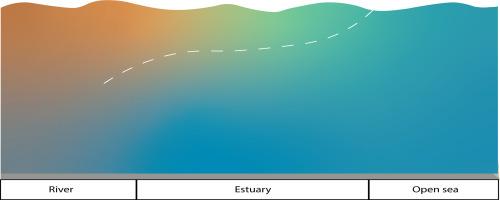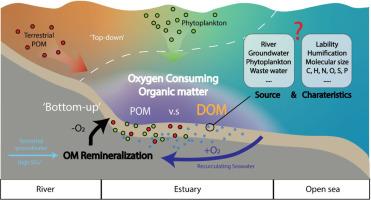溶解有机物在促进沿海缺氧中的作用:确定关键分子和驱动因素
IF 12.4
1区 环境科学与生态学
Q1 ENGINEERING, ENVIRONMENTAL
引用次数: 0
摘要
沿海缺氧对全球水生生态系统的影响越来越大,需要对其潜在机制有更深入的了解。然而,耗氧有机物(OxyC-OM)驱动缺氧形成的概念仍不清楚。本研究以珠江口为例,探讨了颗粒物(POM)和溶解性有机物(DOM)在缺氧和缺氧形成中哪个更重要。我们使用三维激发-发射矩阵荧光光谱和傅里叶变换离子回旋共振质谱(FT-ICR MS)表征并比较了缺氧区和非缺氧区水萃取有机物(We - om,代表不稳定POM部分)和孔隙水DOM (PW-OM)。WE-OM和PW-OM的浓度相当,但DOM的粒径更小,腐殖质化程度更低,表明DOM比WE-OM具有更高的稳定性。因此,DOM被认为是OxyC-OM的主要形式。蛋白质样成分(C3)被鉴定为OxyC-OM的主要成分。此外,我们引入了一种利用DOM分子数据库进行FT-ICR质谱源解析的新方法,揭示了OxyC-OM主要来自藻类细胞内有机物。我们还提出了OM降解产物在缺氧形成中的间接作用,这得到了来自机器学习方法的OxyC-OM光化学和生物反应性预测的支持。本文章由计算机程序翻译,如有差异,请以英文原文为准。


The role of dissolved organic matter in fuelling coastal hypoxia: Identifying key molecules and drivers
The escalating prevalence and impact of coastal hypoxia on global aquatic ecosystems necessitate a deeper understanding of the underlying mechanisms. However, the concept of oxygen-consuming organic matter (OxyC![]() OM) driving hypoxia formation remains unclear. Using the Pearl River Estuary as a case study, this study investigates whether particulate (POM) or dissolved organic matter (DOM) plays a larger role in oxygen depletion and hypoxia formation. We characterize and compare water-extractable organic matter (WE-OM, representing the labile POM fraction) with porewater DOM (PW-OM) from hypoxic and non-hypoxic zones using three-dimensional excitation-emission matrix fluorescence spectroscopy and Fourier-transform ion cyclotron resonance mass spectrometry (FT-ICR MS). Both WE-OM and PW-OM shows comparable concentrations, but DOM has smaller size and lower humification indicating higher lability of DOM than WE-OM. Hence, DOM is suggested the primary form of OxyC
OM) driving hypoxia formation remains unclear. Using the Pearl River Estuary as a case study, this study investigates whether particulate (POM) or dissolved organic matter (DOM) plays a larger role in oxygen depletion and hypoxia formation. We characterize and compare water-extractable organic matter (WE-OM, representing the labile POM fraction) with porewater DOM (PW-OM) from hypoxic and non-hypoxic zones using three-dimensional excitation-emission matrix fluorescence spectroscopy and Fourier-transform ion cyclotron resonance mass spectrometry (FT-ICR MS). Both WE-OM and PW-OM shows comparable concentrations, but DOM has smaller size and lower humification indicating higher lability of DOM than WE-OM. Hence, DOM is suggested the primary form of OxyC![]() OM. The protein-like component (C3) was identified as a major constituent of OxyC
OM. The protein-like component (C3) was identified as a major constituent of OxyC![]() OM. Furthermore, we introduce a novel method using a DOM molecular database for source resolution with FT-ICR MS, revealing that OxyC
OM. Furthermore, we introduce a novel method using a DOM molecular database for source resolution with FT-ICR MS, revealing that OxyC![]() OM primarily originates from algal intracellular organic matter. We also propose an indirect role for OM degradation products in hypoxia formation, supported by photochemical and biological reactivity predictions of OxyC
OM primarily originates from algal intracellular organic matter. We also propose an indirect role for OM degradation products in hypoxia formation, supported by photochemical and biological reactivity predictions of OxyC![]() OM derived from a machine learning approach.
OM derived from a machine learning approach.
求助全文
通过发布文献求助,成功后即可免费获取论文全文。
去求助
来源期刊

Water Research
环境科学-工程:环境
CiteScore
20.80
自引率
9.40%
发文量
1307
审稿时长
38 days
期刊介绍:
Water Research, along with its open access companion journal Water Research X, serves as a platform for publishing original research papers covering various aspects of the science and technology related to the anthropogenic water cycle, water quality, and its management worldwide. The audience targeted by the journal comprises biologists, chemical engineers, chemists, civil engineers, environmental engineers, limnologists, and microbiologists. The scope of the journal include:
•Treatment processes for water and wastewaters (municipal, agricultural, industrial, and on-site treatment), including resource recovery and residuals management;
•Urban hydrology including sewer systems, stormwater management, and green infrastructure;
•Drinking water treatment and distribution;
•Potable and non-potable water reuse;
•Sanitation, public health, and risk assessment;
•Anaerobic digestion, solid and hazardous waste management, including source characterization and the effects and control of leachates and gaseous emissions;
•Contaminants (chemical, microbial, anthropogenic particles such as nanoparticles or microplastics) and related water quality sensing, monitoring, fate, and assessment;
•Anthropogenic impacts on inland, tidal, coastal and urban waters, focusing on surface and ground waters, and point and non-point sources of pollution;
•Environmental restoration, linked to surface water, groundwater and groundwater remediation;
•Analysis of the interfaces between sediments and water, and between water and atmosphere, focusing specifically on anthropogenic impacts;
•Mathematical modelling, systems analysis, machine learning, and beneficial use of big data related to the anthropogenic water cycle;
•Socio-economic, policy, and regulations studies.
 求助内容:
求助内容: 应助结果提醒方式:
应助结果提醒方式:


